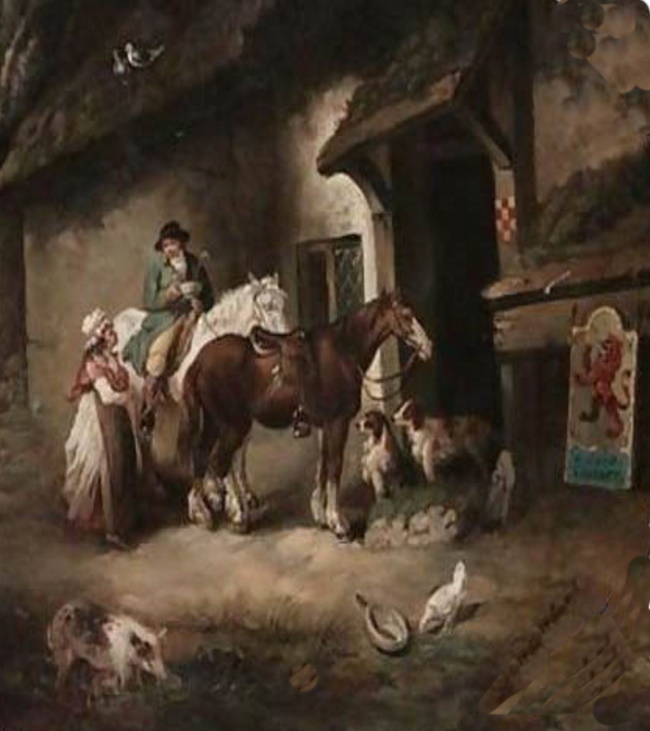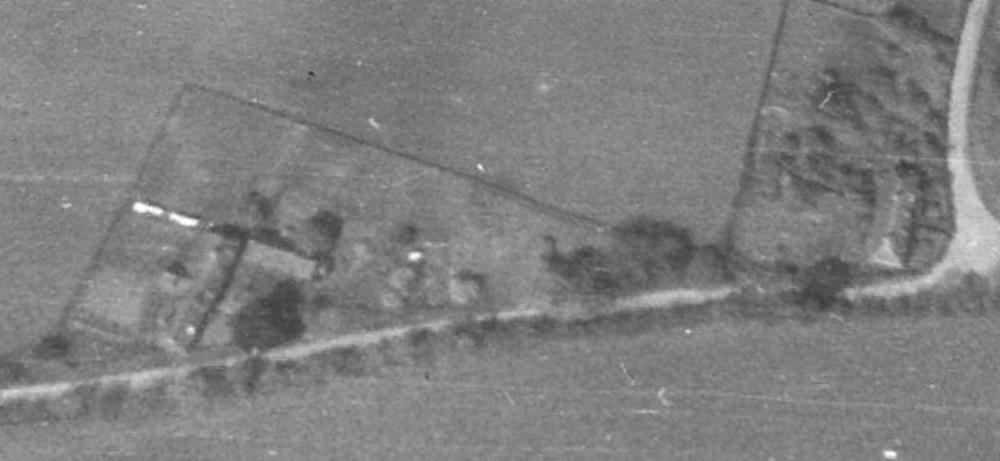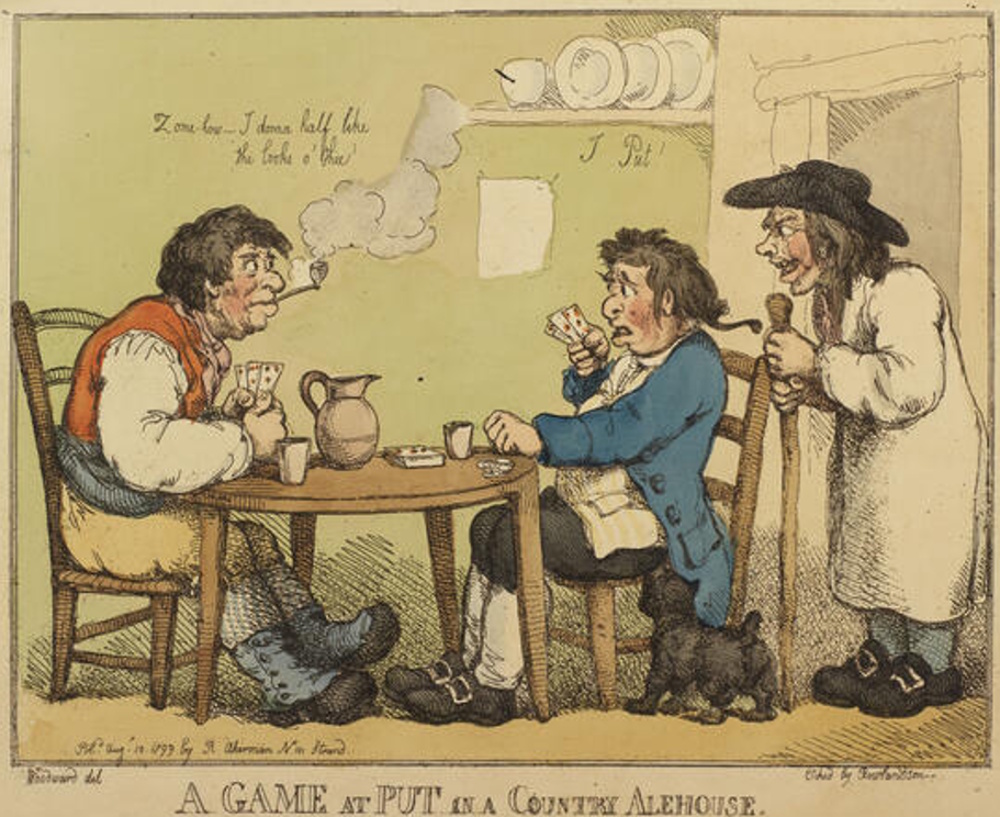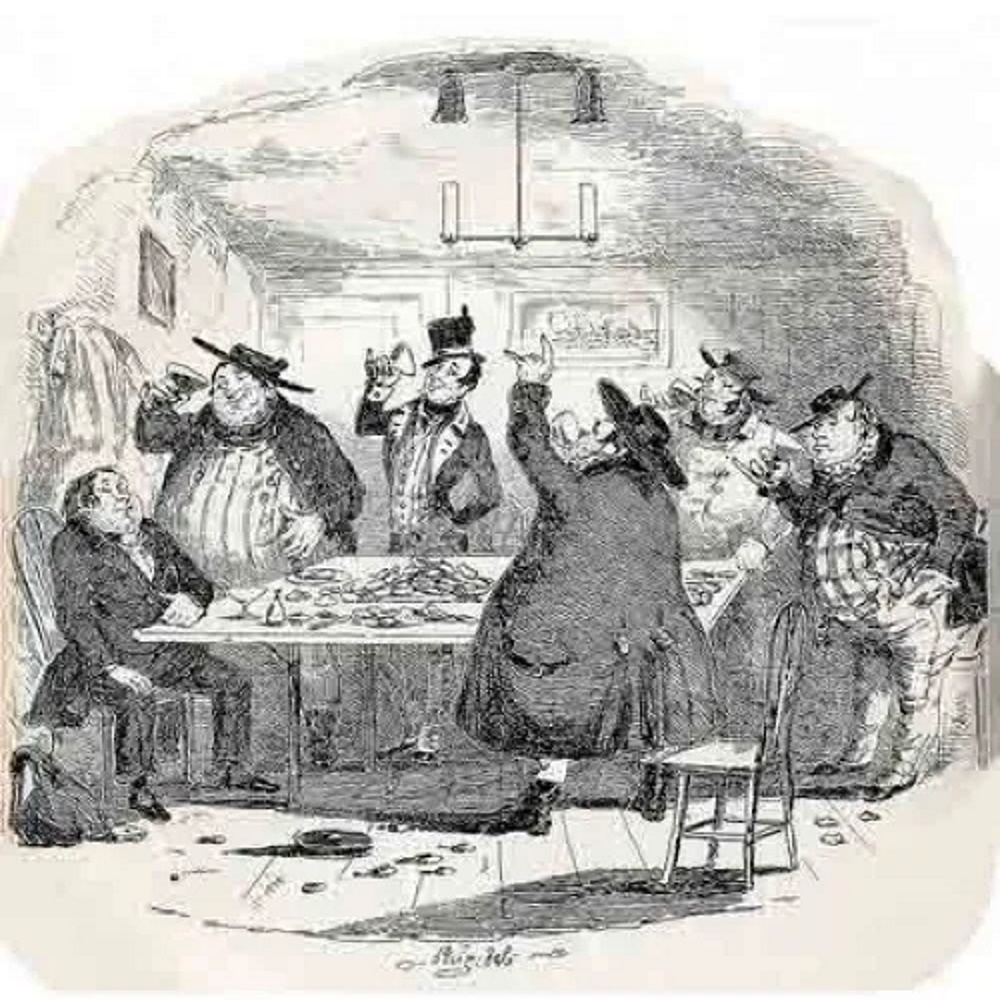
The second oldest alehouse in the old parish of Nonington was “The Redd Lyon”, later “The Red Lyon” and “The Red Lion”, at Frogham, a hamlet some mile and a half or so as the crow flies to the south of St. Mary’s Church in Nonington.
Some of the old alehouse out-buildings still stand on the north side of the Barfreston to Womenswold road about one hundred yards to the west of the junction with Frogham Street.
The aerial photograph below, taken around 1940, shows the ale-house was built at a near right angle to the road and the brick out-buildings were at a right angle to the main building so forming an ‘L’ shape.


Above left: Frogham Street, an extract from the 1859 Poor Law Commissioners map of the Parish of Nonington. The Phoenix, previously The Redd Lyon is in the top left corner on the road to Womenswold.
Above right: Phoenix cottage from the air circa 1940
In the yard in front of the buildings was a deep well still in use into the 1950′s but but now capped and covered. After The Phoenix ale-house closed in 1883 the building was converted into cottages that were eventually demolished in 1959.
The Redd Lyon building was most likely originally built as a farmhouse in the mid to late 17th or possibly the early 18th century with the alehouse business later run as a side-line by the farmer’s wife. It’s most likely that a large room on the ground floor close to the road was used as the tap room with the lady of the house brewing the beers and ales sold there, probably using malt from the Easole Street malt house and hops grown in nearby hop gardens.


Above left: Phoenix Cottages, once The Redd Lyon ale-house se. The elderly couple are Mr & Mrs Jarvis, the woman on the left is believed to be their daughter.
Above right: Phoenix Cottages a few year before they were demolished. The lady with the dog is Mrs. Jarvis, the last tenant. Mrs. Jarvis and her grand-son, Colin, moved to Holt Street when the cottages were demolished in 1959
The old alehouse yard entrance has a large yew tree on its western side which is possibly older than the alehouse, and just along the bank from the yew tree are what now remains of the main alehouse building which now just consist of a section of brick wall enclosing an external door-way with a metal grilled window next to it which appears to be the entrance to a cellar. In the later part of the 18th century when beer and ale began to be more commonly bought in from local breweries this door would have been used to receive wooden casks of beer from the brewer’s dray on the into the cool cellar to be stored and to allow it to settle. The beer would then have been poured into jugs and carried up into the tap room when required. It’s not known at present which of the local breweries supplied beer to the Redd Lyon, but the general rule of thumb in those days was that beer could not be carried on the then very rough and rutted roads for more than five or six miles without being spoiled. Larger villages near to Nonington such as: Ash, Bridge, Eastry, Littlebourne, and Wingham all had thriving breweries, so it’s probable that one or more of these breweries at some supplied beer to the Frogham ale house after home brewing ceased.
At sometime prior to 1826 The Red Lion at Frogham had been acquired by Bradley’s, brewers from Sandwich who went bankrupt in 1825 or 1826.
The Kentish Gazette of 17th January, 1826, advertised an auction to be held at The Bell Inn in Sandwich “on 13th February next” of several freehold and lease hold public houses which were part of the Bradley’s brewery estate. The Red Lion at Frogham was one of the alehouses to be sold at auction, as were The Rose and Crown, now The Two Sawyers, at Woolage Green and The Three Horse Shoes, now The Fitzwalter Arms, at Goodnestone.
Sandwich was not difficult to reach from Frogham and Woolege, but would have been at the extreme limit of the distance that beer could be carried before spoiling. Goodenestone is much nearer to Sandwich.
The prices achieved at the auction for the three above listed premises was published in a report of the auction in the Sussex Advertiser of 20th February, 1826. I have abbreviated the list below to include only the relevant three:
“At the sale of the public houses and other estates, situate in the eastern parts of the County of Kent, which took place at the “Bell Inn,” Sandwich, on Monday last, Messrs. Pott and Denne knocked down the following lots, at the sums affixed to them, viz.:–“Red Lion,” Frogham, £455.… “Rose and Crown,” Womenswould, £166.…. “Three Crowns,” Goodnestone, £620…..The sale-room was most numerously attended”.
Opposite the yard entrance the bank has been cut back to widen the road to allow large horse drawn vehicles to swing easily into the yard from either direction and the remains of a flint wall built to retain and strengthen the bank to prevent its collapse are still visible, but now in a such a sad state of collapse that it will soon disappear.
The first victuallers licence was granted to Abraham Dunne at the Wingham Petty Sessions on June 15th, 1725. Abraham was the licencee until 1729 when Thomas Wraight took over him and ran the alehouse until 1736 when he was succeeded by Thomas White.
In 1744 Thomas Gambole, whose surname was spelt variously: Gambrole, Gambrill, Gamboll or Gambole in various documents, began a long family association with The Redd Lyon. Thomas was succeeded in 1782 by his son, John, and after his death his wife took over the licence in her own right as the “Widow Gambrele” in 1788.

A game of Put in a country alehouse, etching by Thomas Rowlandson, 1799
~~~
After the Gambrele family’s tenure subsequent licencees were:
1795. John Southe.
1802. Michael Brooks.
1820. John Hopper. It was during the tenure of this land-lord that The Red Lion was renamed as The Phoenix in 1833.
+++
At sometime prior to 1826 The Red Lion at Frogham had been acquired by Bradley’s, brewers from Sandwich who went bankrupt in 1825 or 1826.
The Kentish Gazette of 17th January, 1826, advertised an auction to be held at The Bell Inn in Sandwich “on 13th February next” of several freehold and lease hold public houses which were part of the Bradley’s brewery estate. The Red Lion at Frogham was one of the alehouses to be sold at auction, as were The Rose and Crown, now The Two Sawyers, at Woolage Green and The Three Horse Shoes, now The Fitzwalter Arms, at Goodnestone.
The prices achieved at the auction for the three above listed premises was published in a report of the auction in the Sussex Advertiser of 20th February, 1826. I have abbreviated the list below to include only the relevant three :“At the sale of the public houses and other estates, situate in the eastern parts of the County of Kent, which took place at the “Bell Inn,” Sandwich, on Monday last, Messrs. Pott and Denne knocked down the following lots, at the sums affixed to them, viz.:–“Red Lion,” Frogham, £455.… “Rose and Crown,” Womenswould, £166.…. “Three Crowns,” Goodnestone, £620…..The sale-room was most numerously attended”.

This purchase at auction for £455.00 is almost certainly when The Red Lion was acquired by John Plumptre of Fredville and the building and accompanying land became part of the Fredville estate. In December of 1832 John Pembleton Plumptre, the eldest son of the above John Plumptre who inherited Fredville on his father death in 1827, was elected to Parliament as one of the two Eastern Kent M.P’s., the other being Sir Edward Knatchbull, Bt. A dinner to celebrate the election to Parliament was held at The Red Lion on February 4th, 1833. This election success was most likely the reason for the ale-house being renamed The Phoenix as the Plumptre family coat of arms has a phoenix crest. J.P. Plumptre served as an M.P. from December 1832 until January, 1852.

However, the 1839 parish tithe map still recorded the newly named ale-house as The Redd Lyon as information for the tithe map was taken from existing and often out-dated land owners records and not from a full survey as was the Poor Law Commissioners map of 1859. The 1839 parish tithe map records the field directly across the road from the old alehouse as Lyon Field, and the field at the rear as North Lyon Field. By the time of the 1859 parish map was surveyed and drawn North Lyon Field had become Phoenix Field but Lyon Field still retains its pre-1839 name to this day.
1836. William Burville. Licences were normally renewed & new ones issued at the Wingham Division Licencing sessions in September but John Hopper’s licence was transferred to William Burville on November 1st 1836 indicating something must have suddenly happened to him.
1840. William Holloway.
1851. Anne Holloway, wife of William.
1855. Edward Allen. It was during Allen’s tenure that the London, Chatham and Dover Railway line to Dover came through the parish, reaching Dover Town, now Dover Priory, station in July 1861. The line is only a couple of hundred yards up the road from the old alehouse which would have obviously benefited from the dozens of thirsty railway navvies employed in its laying. Indeed, a dozen or so of these navvies, mainly single men, were listed in the 1861 census as lodging in the alehouse, by then under the tenancy of George Webb, whilst others stayed with households near to the railways route through the parish from the hamlet of Ratling in the west to The Phoenix at Frogham in the east.
WEBB George Head Marr 54 Innkeeper Nettlestead, Kent
WEBB Sarah Wife Marr 42 Innkeepers wife Nonington
CRITTENDEN Harriet Sister in law Single 55 Assistant shepherd Nonington
SMITH Joseph Lodger Single 40 Railway Labourer Whitechurch Dorset
DICKINSON William Lodger Single 44 Railway Labourer Trumpington Cambs
MOODY William Lodger Single 35 Railway Labourer North Stoneham Hants
BANKS Robert Lodger Single 35 Railway Labourer RyeSussex
GODDEN William Lodger Single 40 Railway Labourer Saltwood Kent
BROWN Joseph Lodger Single 27 Railway Labourer Kettering Northamptonshire
CLARK William Lodger Single 45 Railway Labourer Newport Pagnell Bucks
MOOR Godfrey Lodger Single 32 Railway Labourer Uckfield Sussex
MONDAY William Lodger Marr 36 Railway Labourer Stansted Deal Hants
The 1861 census also records some navvies and their families living on nearby West Court Down, to the south-west of the alehouse, probably in a shanty town of tents and temporary huts .
1870 Mrs. Sarah Webb, George’s widow, was licencee.
1871. Henry Bates and his wife, Francis, and their five children.
1872. Edwin Colthrup.
In 1872 an agricultural labourer, answering to the name of Smith, who described himself as an “Essex thrower,” was charged with assaulting Richard Bowden, a county constable, at Frogham, near Nonington, while in the execution of his duty.
Read about the assault on Constable Bowden at the Phoenix here
1875. George Colthrup, son of Edwin.
In 1883 The Phoenix closed its doors as an alehouse and the main building was converted into two cottages known as Phoenix Cottages which were demolished in 1959.


David, thanks for the information.
Henry Bates married Frances Jane Weston in Dover1858. His occupations over the years included: watch-maker, publican (briefly at the Pheonix) and hairdresser. He and Frances had eight children – two of whom died in their twenties: Eliza Jane and John Josheph (who died at sea). Their other children were: Alice, Mabel, Harry, George Cephas, Harry, Fanny and Elizabeth. Elizabeth married Arthur Jutton in 1896 – they were my father’s grandparents. My father knew them and also “Uncle Cephas” (George Cephas) and his wife Sophie, who lived and worked on the estate surrounding the Broadway Tower in Worcs. Cephas and Sophie had no children and after Cephas died, Sophie lived with May (Mabel – we believe) in Broadway until c1960.
I’d be happy to include on the page any info you have about Henry Bates
Henry Bates was my Great Great Grandfather